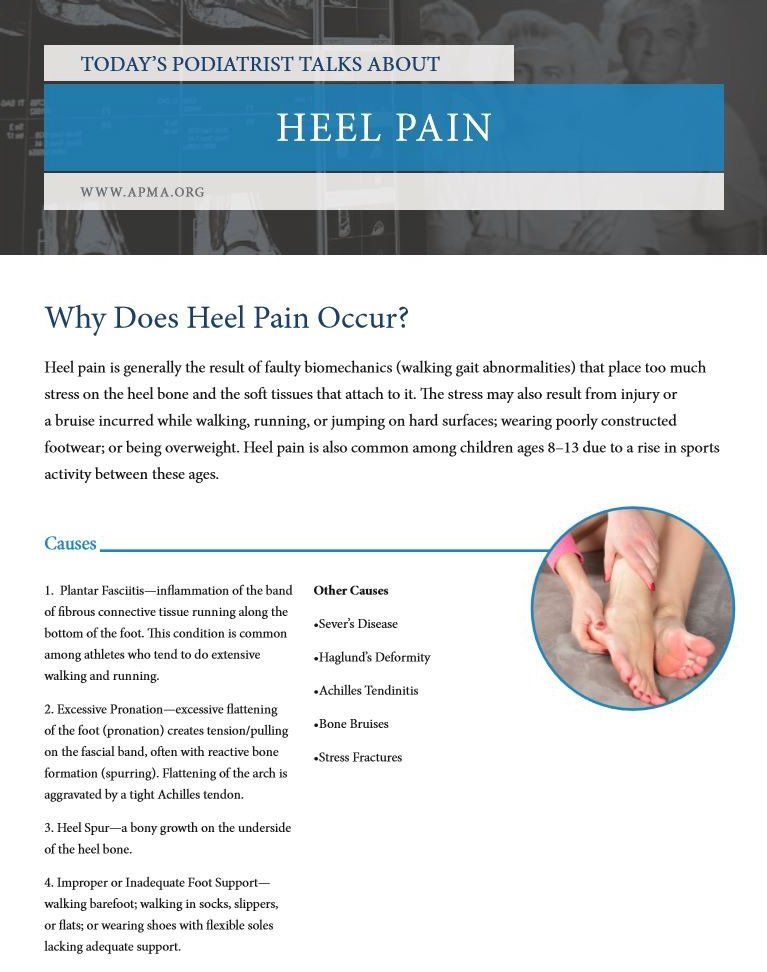Heel Pain & Spurs
New Patients WelcomeMost Insurance AcceptedIn Practice Since 1990
New Patients Welcome | Insurance Accepted | Practicing Since 1990
Arch Pain, Plantar Heel Pain, & Heel Spur Syndrome

There is a long ligament on the bottom of the foot that extends from the heel to the ball of the foot. This is the Plantar Fascia. When this tissue gets strained and inflamed, the condition is known as Plantar Fasciitis. Arch pain across the bottom of the foot at any point between the heel and the ball of the foot may be Plantar Fasciitis and is sometimes associated with a heel spur. Bone is living tissue and reacts to tension. A plantar heel spur is a projection of bone coming from the bottom surface of the heel bone pointing to your toes and is a reaction from the Plantar Fascia’s attachment. When the arch rolls in, the foot flattens and lengthens. The Plantar Fascia stretches and pulls at its insertion into the heel bone creating the spur. The spur is a misnomer. When looking at the side view on an x-ray, the projection appears like a pointy spur. This is only in 2 dimensions. Since the ligament is about 1 inch wide, so is the spur. It is a bone shelf.
The most common cause of Plantar Fasciitis relates to a faulty structure and / or mechanics of the foot. For example, people who have problems with their arches, such as overly flat feet or high-arched feet, are more prone to developing plantar fasciitis. In most cases, arch pain develops from overuse, unsupportive shoes, weight gain or acute injury.
Heel pain may also be due to other causes, such as a stress fracture, tendonitis, arthritis, nerve irritation or, rarely, a cyst. Because there are several potential causes, it is important to have heel pain properly diagnosed. We can distinguish between all the possibilities and to determine the underlying source of your heel pain.
People with plantar fasciitis often describe the pain as worse when they get up in the morning or after they have been sitting for long periods. After a few minutes of walking, the pain decreases because walking stretches the fascia. For some people, the pain subsides but returns after spending long periods on their feet.
To arrive at a diagnosis, we will obtain your medical history and examine your foot. Throughout this process, we rule out all possible causes for your heel pain other than plantar fasciitis.
Also, diagnostic imaging studies, such as x-rays or other imaging modalities, may be used to distinguish the different types of heel pain. Sometimes heel spurs are found in patients with plantar fasciitis, but these are rarely a source of pain. When they are present, the condition may be diagnosed as plantar fasciitis/heel spur syndrome.
Nonsurgical Treatment of Plantar Fasciitis Begins With First-Line Strategies, Which You Can Begin at Home
- Avoid going barefoot: When you walk without shoes, you put undue strain and stress on your plantar fascia
- Ice: Putting an ice pack on your heel for 20 minutes several times a day helps reduce inflammation. Place a thin towel between the ice and your heel; do not apply ice directly to the skin
- Limit activities: Cut down on extended physical activities to give your heel a rest
- Shoe modifications: Wearing supportive shoes that have good arch support and a slightly raised heel reduces stress on the plantar fascia. The back or counter of the shoe and the mid-sole or shank should be very firm or stiff
- Medications: Oral nonsteroidal anti-inflammatory drugs (NSAIDs), such as ibuprofen, may be recommended to reduce pain and inflammation
- Padding, taping and strapping - Placing pads in the shoe softens the impact of walking. Taping and strapping help support the foot and reduce strain on the fascia.
- Orthotic devices: Custom foot orthotic devices that fit into your shoe help correct the underlying structural abnormalities causing the plantar fasciitis
- Injection therapy: In some cases, corticosteroid injections are used to help reduce the inflammation and relieve pain
- Removable walking cast: A removable walking cast may be used to keep your foot immobile for a few weeks to allow it to rest and heal
- Night splint: Wearing a night splint allows you to maintain an extended stretch of the plantar fascia while sleeping. This may help reduce the morning pain experienced by some patients
- Physical therapy: Exercises and other physical therapy measures may be used to help provide relief

When Is Surgery Needed?
Although most patients with plantar fasciitis respond to nonsurgical treatment, a small percentage of patients may require surgery. If, after several months of nonsurgical treatment, you continue to have heel pain, surgery will be considered. We will discuss the surgical options with you and determine which approach would be most beneficial for you.
No matter what kind of treatment you undergo for plantar fasciitis, the underlying causes that led to this condition may remain. Therefore, you will need to continue with preventive measures. Wearing supportive shoes, stretching (after pain resolves) and using custom orthotic devices are the mainstay of long-term treatment for plantar fasciitis.
Common Treatment Options for Heel Spurs
- Cushioned footwear
- Custom orthotics
- Exercises
- Night splints and braces
- Plantar procedures
- Surgical options
The Personal Attention You Deserve
Dr. Mickenberg of Ambulatory Foot Care will give you the personal care that you deserve. Recovery time is always lessened when you and your condition receive personal attention. Call (410) 255-0040 to schedule your appointment. New patients are always welcome at our locally owned practice.








Share On: